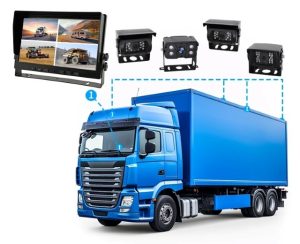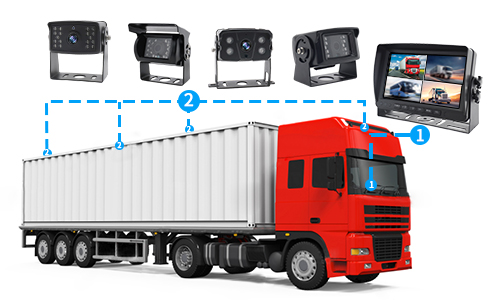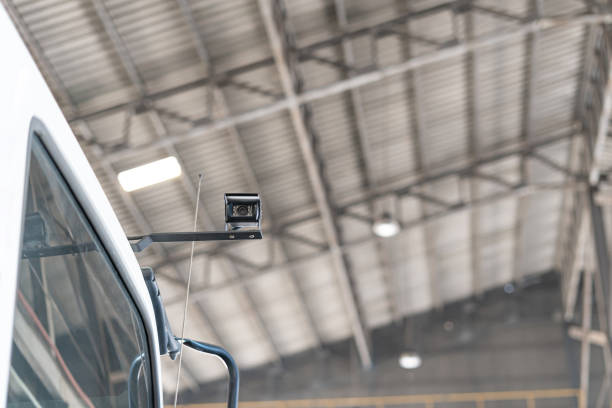Truck surveillance camera kits equipped with multi-camera layouts and blind spot coverage offer substantial advantages over traditional dashcams, particularly in the context of fleet operations and commercial trucking. While dashcams serve as valuable tools for recording incidents and monitoring driver behavior, they often fall short in providing comprehensive situational awareness and proactive safety measures. In contrast, advanced truck surveillance camera kits deliver a 360-degree view of the vehicle’s surroundings, significantly enhancing safety, operational efficiency, and regulatory compliance.
Comprehensive Situational Awareness
Traditional dashcams typically focus on recording footage from a single vantage point, often the front windshield, which limits their ability to capture events occurring in blind spots or from other angles. This narrow perspective can result in critical incidents going unnoticed or unrecorded. Conversely, truck surveillance camera kits with multi-camera layouts provide a holistic view by integrating cameras positioned at strategic locations around the vehicle, including the front, rear, sides, and cargo area. This arrangement ensures that drivers and fleet managers have real-time access to comprehensive visual information, facilitating safer maneuvers and better-informed decision-making.
For instance, when a truck driver activates the turn signal, the corresponding side camera feed can automatically display on the in-cab monitor, alerting the driver to the presence of nearby vehicles or pedestrians in the blind spot. Such dynamic camera integration enhances situational awareness, particularly in complex driving environments like urban areas or construction zones.

Enhanced Safety and Risk Mitigation
The implementation of multi-camera truck surveillance camera kits has been shown to significantly reduce the likelihood of accidents and associated liabilities. By eliminating blind spots and providing clear visibility of surrounding obstacles and hazards, these systems enable drivers to execute maneuvers with greater confidence and precision. Moreover, the continuous recording capabilities of these systems ensure that critical events are documented, providing valuable evidence in the event of disputes or accidents.
Studies have indicated that vehicles equipped with multi-camera systems can reduce blind spot-related crashes by up to 23%. This reduction not only enhances driver safety but also contributes to lower insurance premiums and decreased maintenance costs, as fewer accidents lead to less vehicle wear and tear.
Integration with Fleet Management Systems
Modern truck surveillance camera kits often come equipped with advanced features such as GPS tracking, telematics integration, and cloud-based data storage. These capabilities allow fleet managers to monitor vehicle locations, driver behavior, and operational metrics in real-time, facilitating proactive management and optimization of fleet operations. For example, telematics data can provide insights into driving patterns, enabling managers to identify and address unsafe behaviors, reduce fuel consumption, and improve overall efficiency.
Furthermore, the integration of video footage with telematics data creates a comprehensive record of events, enhancing the accuracy of incident analysis and supporting data-driven decision-making. This synergy between video monitoring and telematics systems is instrumental in achieving operational excellence and maintaining high safety standards.
 Compliance with Regulatory Standards
Compliance with Regulatory Standards
In many jurisdictions, commercial vehicles are subject to stringent safety regulations that mandate the implementation of certain technologies to enhance road safety. Multi-camera truck surveillance camera kits can assist fleet operators in meeting these regulatory requirements by providing verifiable evidence of compliance and demonstrating a commitment to safety. For instance, the continuous recording of driving activities can serve as documentation for regulatory audits, while the real-time alerts generated by the system can help drivers adhere to traffic laws and safety protocols.
Additionally, the use of such advanced monitoring systems can be advantageous during insurance assessments and claims processes, as they offer objective and reliable data that can expedite claim resolutions and potentially reduce liability exposure.
Limitations of Traditional Dashcams
While dashcams are beneficial for recording incidents and monitoring driver behavior, they possess several limitations that can impede their effectiveness in enhancing vehicle safety. Primarily, dashcams offer a limited field of view, typically focusing on the front of the vehicle, which can result in blind spots and missed incidents occurring outside the camera’s range. This limitation is particularly concerning in large vehicles like trucks, where blind spots are more prevalent and pose significant safety risks.
Moreover, traditional dashcams often lack integration with other vehicle systems, such as telematics or GPS, reducing their utility in comprehensive fleet management and real-time monitoring. They also generally do not provide dynamic camera feeds that adapt to driving conditions, such as automatically displaying side or rear views when turning or reversing, which can enhance situational awareness and prevent accidents.
Conclusion
In conclusion, while traditional dashcams serve as valuable tools for recording driving activities and incidents, they fall short in providing the comprehensive coverage and proactive safety features offered by multi-camera truck surveillance camera kits. The integration of multiple cameras positioned around the vehicle, combined with advanced features like telematics integration and real-time alerts, significantly enhances driver awareness, reduces accident risks, and supports efficient fleet management. For fleet operators seeking to improve safety standards, operational efficiency, and regulatory compliance, investing in a multi-camera truck surveillance camera kit is a prudent and forward-thinking decision.








